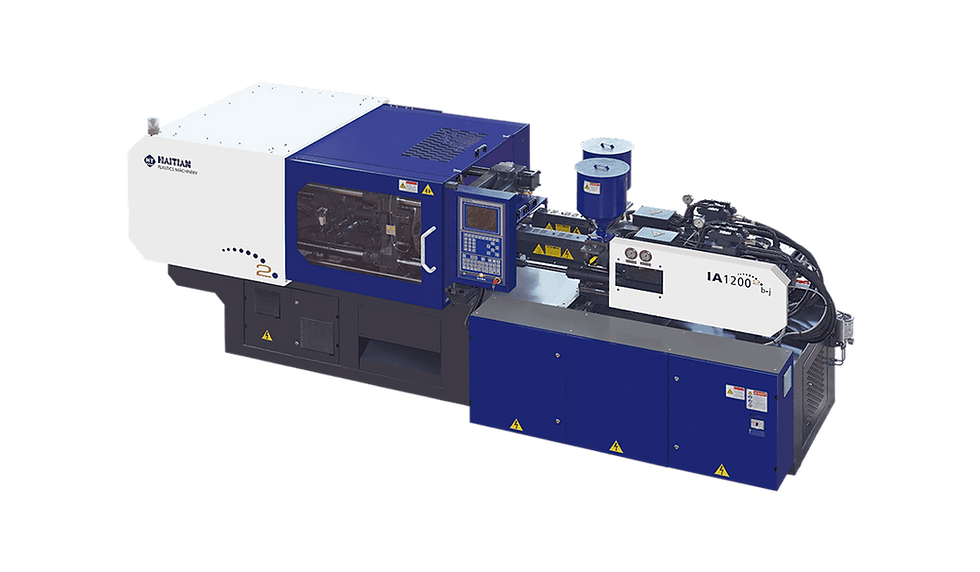Plastic Injection Molding Machines: Everything You Need to Know for Efficient Manufacturing
- Haitian

- Apr 5
- 4 min read
Updated: Apr 9
Introduction
Plastic injection molding machines have revolutionized the manufacturing industry, enabling businesses to produce high-quality plastic parts quickly and efficiently. Whether you're in the automotive, medical, electronics, or consumer goods industry, understanding how these machines work can significantly impact your production process.
In this blog, we will explore what plastic injection molding machines are, how they work, their benefits, types, and key considerations for selecting the right machine for your business.
What is a Plastic Injection Molding Machine?

A plastic injection molding machine is a piece of equipment used to manufacture plastic parts by injecting molten plastic into a mold cavity. The process involves melting plastic pellets, injecting the material into a mold, cooling it to solidify, and ejecting the finished product.
This technique is widely used because it allows for mass production of complex plastic components with high precision and minimal waste.
How Does a Plastic Injection Molding Machine Work?
The plastic injection molding process consists of several key stages:
Clamping – The mold halves are secured together using a clamping unit.
Injection – Plastic pellets are heated and injected into the mold cavity at high pressure.
Cooling – The plastic material cools and solidifies within the mold.
Ejection – The finished plastic part is ejected from the mold for further processing or packaging.
Each of these steps is crucial in ensuring high-quality plastic parts with minimal defects.
Benefits of Using Plastic Injection Molding Machines
There are several advantages to using plastic injection molding machines in manufacturing:
High Efficiency & Speed – Once the mold is created, production cycles are fast, allowing for large-scale manufacturing.
Precision & Consistency – Injection molding ensures that every part is identical, reducing errors and defects.
Cost-Effective for Mass Production – While initial tooling costs may be high, per-unit costs drop significantly with large production runs.
Material Versatility – Various plastic materials can be used, including thermoplastics, thermosetting plastics, and elastomers.
Reduced Waste – The process minimizes material waste, and excess plastic can often be recycled.
Automated Process – Many modern plastic injection molding machines come with automation features, reducing labor costs and human errors.
Types of Plastic Injection Molding Machines
Choosing the right plastic injection molding machine depends on your production needs. Here are the three main types:
1. Hydraulic Injection Molding Machines
Hydraulic machines are the most traditional type, offering high clamping force and durability. They are ideal for producing large, heavy-duty parts but consume more energy than other types.
2. Electric Injection Molding Machines
Electric machines are known for their precision, speed, and energy efficiency. They have a lower operating cost and provide cleaner production, making them suitable for industries requiring high precision, such as medical and electronics manufacturing.
3. Hybrid Injection Molding Machines
Hybrid machines combine the best of hydraulic and electric technologies, offering energy efficiency, power, and precision. They provide an excellent balance between cost-effectiveness and performance.
Key Considerations When Choosing a Plastic Injection Molding Machine
Before investing in a plastic injection molding machine, consider the following factors:
Production Volume – Determine the number of parts you need to produce to select the appropriate machine size.
Material Type – Different machines are compatible with specific plastic materials. Choose one that suits your production needs.
Clamping Force – The machine’s clamping force should be sufficient to keep the mold closed during injection.
Shot Size – This refers to the maximum amount of plastic the machine can inject in one cycle. It should align with your part size requirements.
Cycle Time – Consider how quickly the machine can complete a cycle to ensure efficient production.
Automation Features – Advanced machines come with automation features such as robotic part removal and quality control systems.
Energy Efficiency – Opt for machines that consume less power to reduce operational costs.
Budget – Ensure that the machine you choose provides the best value for your investment.
Applications of Plastic Injection Molding Machines
Plastic injection molding machines are used in various industries, including:
Automotive Industry – Manufacturing dashboards, bumpers, and other plastic components.
Medical Industry – Producing syringes, surgical instruments, and medical device casings.
Consumer Goods – Creating everyday items like plastic containers, bottles, and toys.
Electronics – Manufacturing plastic casings for devices, connectors, and components.
Packaging Industry – Producing plastic caps, closures, and food containers.
Latest Trends in Plastic Injection Molding Machines
The industry is continuously evolving, with several key trends shaping the future of plastic injection molding:
Sustainable Manufacturing – More companies are using biodegradable plastics and recycled materials to reduce environmental impact.
Smart Manufacturing – IoT-enabled machines provide real-time monitoring and predictive maintenance for improved efficiency.
Lightweighting – Reducing the weight of plastic components to enhance performance and sustainability.
Advanced Materials – Development of high-performance polymers for specialized applications.
Automation & AI Integration – Enhanced automation with AI-driven quality control and robotic assistance.
Plastic injection molding machines are an essential part of modern manufacturing, providing a cost-effective and efficient solution for producing high-quality plastic parts. Whether you are a small business or a large-scale manufacturer, investing in the right machine can improve production efficiency, reduce waste, and increase profitability.
By understanding the working principles, benefits, types, and key selection factors, you can make informed decisions to optimize your manufacturing process. As the industry continues to evolve, adopting the latest trends in sustainable and smart manufacturing will keep your business competitive.






Comments